Thursday, February 23, 2006
Monday, February 20, 2006
On this day in 1902
Ansel Adams is born
The famous western photographer Ansel Adams is born in San Francisco. Adams' dramatic black and white images of Yosemite and the West are some of the most widely recognized and admired photographs of the 20th century.
Ansel Adams discovered his love of photography and the West during a family trip to Yosemite when he was 14 years old. He made his first photographs of the dramatic Yosemite Valley during that trip, and he returned to photograph the park every year thereafter for the rest of his life.
Adams soon developed a tremendous passion and talent for photography, though it remained only a hobby for many years. From childhood, Adams had studied piano, and as a young man he embarked on a promising career as a concert pianist. It was only when he was in his late 20s that Adams decided to abandon music and make a career out of photography instead, choosing to make the West the focus of his work. During the next 20 years, Adams' distinctive treatment of the western landscape won him a dedicated following, especially among the growing community of outdoor enthusiasts in California. Today his majestic portraits of the snow-covered Yosemite Valley and haunting images of Saguaro cacti under an Arizona moon are so familiar as to be visual cliches. It is hard to remember that when Adams first published them, the pictures had a crystalline purity that few other nature photographers had achieved.
A dedicated conservationist, Adams deliberately used his photos to inspire a semi-religious reverence for the natural world that he hoped would encourage more Americans to protect and preserve wilderness. A lifelong member of the Sierra Club (when it was still considered a reputable organization), Adams provided images for many of the club's early publications in the 1960s.
Besides being an accomplished artist, Adams was also a technical innovator and a teacher. Along with several other photographers, Adams founded "Group f/64," which was dedicated to promoting deep-focus photography and the use of "straight" images free from darkroom trickery. He created a number of innovative photographic techniques that he introduced to the general public through a series of books and an annual workshop in Yosemite.
In recognition of his lifelong efforts supporting the national park system, Mt. Ansel Adams in Yosemite was named in his honor shortly after he died in 1984.
The famous western photographer Ansel Adams is born in San Francisco. Adams' dramatic black and white images of Yosemite and the West are some of the most widely recognized and admired photographs of the 20th century.
Ansel Adams discovered his love of photography and the West during a family trip to Yosemite when he was 14 years old. He made his first photographs of the dramatic Yosemite Valley during that trip, and he returned to photograph the park every year thereafter for the rest of his life.
Adams soon developed a tremendous passion and talent for photography, though it remained only a hobby for many years. From childhood, Adams had studied piano, and as a young man he embarked on a promising career as a concert pianist. It was only when he was in his late 20s that Adams decided to abandon music and make a career out of photography instead, choosing to make the West the focus of his work. During the next 20 years, Adams' distinctive treatment of the western landscape won him a dedicated following, especially among the growing community of outdoor enthusiasts in California. Today his majestic portraits of the snow-covered Yosemite Valley and haunting images of Saguaro cacti under an Arizona moon are so familiar as to be visual cliches. It is hard to remember that when Adams first published them, the pictures had a crystalline purity that few other nature photographers had achieved.
A dedicated conservationist, Adams deliberately used his photos to inspire a semi-religious reverence for the natural world that he hoped would encourage more Americans to protect and preserve wilderness. A lifelong member of the Sierra Club (when it was still considered a reputable organization), Adams provided images for many of the club's early publications in the 1960s.
Besides being an accomplished artist, Adams was also a technical innovator and a teacher. Along with several other photographers, Adams founded "Group f/64," which was dedicated to promoting deep-focus photography and the use of "straight" images free from darkroom trickery. He created a number of innovative photographic techniques that he introduced to the general public through a series of books and an annual workshop in Yosemite.
In recognition of his lifelong efforts supporting the national park system, Mt. Ansel Adams in Yosemite was named in his honor shortly after he died in 1984.
Wednesday, February 15, 2006
Wine Glasses 101
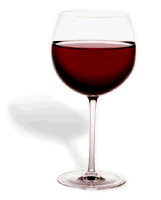
If a camera body is just a box that holds film, then a wine glass should be nothing more than a bowl to slurp wine out of, right? Maybe not. So how do you choose the right wine glass?
Unsuspecting drinkers are likely to be confronted by massive goblets large enough to comfortably house several goldfish. Or cut crystal that looks pretty but merely masks the wine inside. Or thick rims that simply block the wine from your mouth.
Glassware isn’t that hard to figure out. And while I hate to admit it, the proper glass really does make all the difference in enjoying wine — whether it’s $5 table wine or wallet-busting Grand Crus.
The bottom line. Find a set of glasses that fits your budget and your wine-drinking habits. Maximilian Riedel, CEO of Riedel Crystal of America and an 11th generation glassmaker, offers a decent rule of thumb: “What you spend on average for a bottle of wine, you should spend on your glass.”
Totally reasonable, though Riedel stemware — functionally the Rolls-Royce of wine glasses — might not fit everyone’s budget, seeing as it can cost well over $50 per hand-blown stem for the top-end Sommelier line. Still, it’s possible to find good glasses for about $10 apiece.
Good machine-blown glasses from German-made Spiegelau (purchased in September 2004 by Riedel, which is headquarted in Austria) average $10 to 12 per glass, and Riedel’s own entry-level Wine series starts around $10. I’m partial to the Connoisseur line available at Cost Plus stores, which average about $7 per glass.
To be avoided at all costs are those cheap, six-to-a-box travesties, which appeal in an Ikea-impulse-buy sort of way but don’t really warrant use for anything more than apple juice. Their shortcomings are revealed in even the most rudimentary taste tests. (Honest, try it yourself). Assign them to water duty and buy yourself a decent set.
Shape up. No need to go all wine-geek and buy a different glass for every type of wine you drink, but one set each for red and white will make you a happier camper. The aromas and textures of red wines and white wines are different enough to justify separate sets.
Red wines especially require a bowl big enough to provide what Bob Betz, a Master of Wine and owner of Betz Family Winery in Woodinville, Wash., calls “critical mass in the glass”: ample space to properly expose wine to air when it's swirled, and for aromas to be directed into your nose (where most of the “taste” is actually perceived.) A bowl size of 20 to 25 ounces seems about right for red-wine glasses; white wine functions well with bowls around 11 to 13 ounces, though a good glass for white Burgundy might require something closer to 20 ounces
“I was a cynic,” says Betz, “and I was proven wrong time and again.”
Beyond red or white, you’ll want to choose a specific shape. Among Riedel’s 160 shapes, the biggest sellers are Bordeaux-style glasses, meant for cabernet sauvignon and the like, followed by chardonnay glasses.
Pinot noir lovers might prefer a Burgundy-style glass that highlights the grape’s more subtle qualities. And sparkling wine truly benefits from a proper tapered flute — narrow enough to retain the bubbles but wide enough to release the wine's aromas.
These shapes are anything but arbitrary. The Riedel company invites winemakers to collaborate on new designs for specific types of wine, often sending them over 200 shapes to evaluate.
“It’s a Ping-Pong game,” Maximilian Riedel says. “We send them six, they send us back three.”
This back-and-forth can last for months until a final tasting round narrows it down to one perfect shape.
As for stems, sturdier is better — especially if you have clumsy friends. And 29-year-old Riedel also recently introduced his own pet project: His O Series glasses, designed for younger, casual drinkers, use the classic bowl shapes but are stemless.
What to avoid. The most overlooked feature in glassware is the rolled rim, easily detectable by a slightly bulging lip (versus a narrow tapered one). Not only does this block the wine from leaving the glass, it’s a sign of inferior quality. Those six-for-$10 packs almost inevitably have rolled rims.
Skip skinny or shallow glasses with more looks than functionality. Unless you’re drinking riesling, flared bowls or rims are unnecessary. Ditto flourishy stems, or those massive jug-like goblets.
Cut or etched designs may enhance the look of the crystal, but mostly just obscure the wine. Flat-bottomed glasses don’t really let you swirl the wine, which releases its flavor.
Keep it clean. Many wine pros are freaked out about using soap, but the rules aren’t quite so simple. Everyday glasses can survive the dishwasher provided you steer clear of harsh detergents and carefully wipe the glass afterwards. And don’t crowd them in the dishwasher.
More expensive stemware should be hand-washed; dish soap is OK on the outside if you apply it with a finger, but don’t put soap inside the glass. If you aren’t going to wash a glass the same evening you use it, leave some water inside to prevent staining.
Yearning to breathe free. Cabinets impart their own musty, veneered scents to a glass. I battled with a stale scent from my own kitchen cabinets for nearly two years, wiping out and shaking my glasses to clear out the must, before I gave up and moved them to a neutral-smelling closet.
Give the cabinets where you store your glasses a good cleaning, Don’t put glasses immediately into new or newly stained woodwork. Don’t store them upside down (it’ll only trap stale odors) and keep them freshly washed, at least once a month. “They’re not supposed to be dust-catchers,” Riedel says.
Betz endorses a popular technique of seasoning the glass with a bit of wine he’s about to taste: pour a bit in, swirl it around, then dump it out (or into the next person’s glass) before pouring yourself a full serving. The wine rinse helps wash away residue and off scents.
Monday, February 13, 2006
Sulfites & Wine
Grape skins not only host the yeast that ferments grapes into wine, they also contain vinegar bacteria that can spoil new wine. Adding sulfites (sulfur dioxide and its salts) helps to prevent the spoilage. Sulfites inhibit the growth of molds and bacteria, curtail oxidation (browning), and also preserve flavor.
According to the Food and Drug Administration (FDA), one percent of the general population and five percent of asthmatics are affected by sulfites. Sulfite allergy symptoms range from mild gastrointestinal distress to death. If you were allergic to sulfites, you would know it. You would be sensitive to many conventional supermarket and convenience foods that are preserved with sulfites.
Getting a headache after drinking wine is usually the result of three factors: sulfites, amines, or overindulgence. We all know when we’ve had too many, but the cause of a throbbing head after one glass of wine has been the subject of numerous studies.
Many people incorrectly blame sulfites for their wine headaches. If your headaches are severe only when you drink red wine, you can rule out sulfites as the culprit. Many highly-processed foods have had sulfites added to them. And, contrary to popular opinion, white wines contain even more than reds!
The third suspect is a group of chemicals called amines, which occur naturally in fermented foods and beverages. Wine contains two kinds: histamines and tyramines. A study conducted by Mark Daeschel, Professor of Food Science and Technology at Oregon State University, confirmed that histamines dilate blood vessels in the brain, while tyramines constrict them. Either effect may cause headaches in people sensitive to one or both of the chemicals. In this case, red wines do generally have a higher content than white wines, but as with sulfites, few people suffer from sensitivity to amines.
A Few Facts
All wines contain sulfites naturally. They are a by-product of fermentation.
There is no such thing as wines that contain no sulfites, or sulfite-free wines.
There are wines that can be labeled as "No Sulfites Added," but these wines still contain between 6 and 15 ppm (parts per million).
There are less sulfites used in wine production today than at any other time in history. Better technology, equipment, and sanitation practices all contribute to less bacterial spoilage, and therefore less need for adding sulfites.
Wines labeled "Organic" do not contain added sulfites, those labeled "Made from Organically Grown Grapes" may contain added sulfites.
To this day, there has yet to be found a better way to keep wine from spoiling than the use of sulfite.
According to the Food and Drug Administration (FDA), one percent of the general population and five percent of asthmatics are affected by sulfites. Sulfite allergy symptoms range from mild gastrointestinal distress to death. If you were allergic to sulfites, you would know it. You would be sensitive to many conventional supermarket and convenience foods that are preserved with sulfites.
Getting a headache after drinking wine is usually the result of three factors: sulfites, amines, or overindulgence. We all know when we’ve had too many, but the cause of a throbbing head after one glass of wine has been the subject of numerous studies.
Many people incorrectly blame sulfites for their wine headaches. If your headaches are severe only when you drink red wine, you can rule out sulfites as the culprit. Many highly-processed foods have had sulfites added to them. And, contrary to popular opinion, white wines contain even more than reds!
The third suspect is a group of chemicals called amines, which occur naturally in fermented foods and beverages. Wine contains two kinds: histamines and tyramines. A study conducted by Mark Daeschel, Professor of Food Science and Technology at Oregon State University, confirmed that histamines dilate blood vessels in the brain, while tyramines constrict them. Either effect may cause headaches in people sensitive to one or both of the chemicals. In this case, red wines do generally have a higher content than white wines, but as with sulfites, few people suffer from sensitivity to amines.
A Few Facts
All wines contain sulfites naturally. They are a by-product of fermentation.
There is no such thing as wines that contain no sulfites, or sulfite-free wines.
There are wines that can be labeled as "No Sulfites Added," but these wines still contain between 6 and 15 ppm (parts per million).
There are less sulfites used in wine production today than at any other time in history. Better technology, equipment, and sanitation practices all contribute to less bacterial spoilage, and therefore less need for adding sulfites.
Wines labeled "Organic" do not contain added sulfites, those labeled "Made from Organically Grown Grapes" may contain added sulfites.
To this day, there has yet to be found a better way to keep wine from spoiling than the use of sulfite.
Wednesday, February 08, 2006
The winter of my discontent
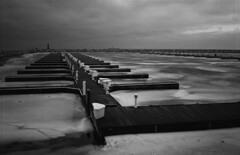
Winter is the worst time for being a photographer.
Not because snow covers all the details that I'd normally want to capture. On the contrary, the smooth curves of snow blanketing ordinary objects can create a landscape to which only desert dunes can compare. The stark contrast nature throws at us begs the photographer to put in a fresh roll of Tri-X black and white film and find some untrampled snow. Or, for that matter, fresh tracks to emphasize our ability as humans to persevere in any weather.
It's also not because of the cold. Although that certainly doesn't help. Try holding a classic metal-body camera in 10 degree weather without gloves and you'll soon start wondering how long it takes to get frostbite. On the other hand (no pun intended), a pair of mittens that are nicely insulated will make it next to impossible to work the fingertip camera controls.
All that aside, the hardest part of winter photography is the all-too-short days. For many of us who are only amateur photographers, the better parts of our days are wasted trying to remain gainfully employed. In my case, I leave the house within a half hour of sunrise. The next 4 hours are spent in a windowless office, wondering if the sun is still obscured entirely by clouds, as has been the case for 24 of the past 30 days. Then I have an hour lunch spent running errands, scouting potential photo ops, and occasionally remembering to eat.
This is followed by another four windowless hours, often occupied by looking at other people's photos online for much of that time (don't tell my boss, please). At 5pm I am released, just in time to glimpse the sun as it disappears beyond the horizon.
I suppose I should look at the bright side. Things can always be worse. I could be in New Jersey right now.
Tuesday, February 07, 2006
Koyt: A beer worth fighting for

In the beer halls of Haarlem, a picturesque Dutch city noted for its canal houses, flower-filled windows, and rich beer-brewing past, you can sip koyt, a brew so delicious that thousands of people once fought for the right to drink it—and changed the course of Dutch history.
In Café Studio, a bar on Haarlem's town square, a jovial, beer-loving historian named Walter Schelfhout tells me the tale of the 15th-century dustup. ''Back then, fortunes were made in the beer trade,'' he begins. Koyt, a type of beer made with herbs (including sweet gale, bergamot, and coriander), was the city's prime beer export, sold from Bremen to Picardy and popular in the province of Friesland, which functioned as a feudal state governed by merchants—who, incidentally, imposed stiff taxes on all imported and exported goods.
In 1487 Friesland's largest city, Leeuwarden, banned all foreign beer, including Haarlem's, to protect sales of the local stuff. But one innkeeper—pressured by his patrons, most of them peasants—kept serving Haarlem's dark, aromatic koyt. Soon enough, city authorities came to confiscate the beer, and a huge brawl erupted. The customers fled to a sympathizer's home, where they were besieged. ''Things looked grim,'' says Schelfhout. Immediately, the homeowner's brother started mobilizing support in the countryside, and several days later a peasant army 8,000 men strong marched into Leeuwarden, demanding not just Haarlem beer but fair trade as well. When their demands were ignored, they rescued their friends—and sacked the city while they were at it.
In the aftermath, the beer ban was lifted and trade duties lowered. The merchants of Leeuwarden never fully recovered their power, and droughts and major fires in the province further weakened their control; by the early 1500s Hapsburg Emperor Charles V, ruler of Spain, Germany, and most of present-day Holland, took over Friesland, which had never before been governed by a foreigner.
As for Haarlem koyt, it flourished until the 19th century, when lighter, easier-to-digest pilsner beers from Bohemia eclipsed traditional brews. The last city brewery folded in 1916. But thanks to Schelfhout and a few other historians, who found a 1407 recipe for koyt in the city archives and revived it for Haarlem's 750th anniversary five years ago, the beer is once again being brewed—at the Schaapskooi Trappist brewery in southwest Holland, under the name Jopen Koyt (jopen is a type of barrel).
Savoring my glass of Jopen Koyt (not yet exported from Holland), I detect notes of nuts, orange, and violets, with an aftertaste of history. Now this is a beer worth fighting for.
Originally printed in the April 2000 issue of Saveur.
It was the best of wines. It was the worst of wines.
As the highest (and only) authority of wine reviews at Focusing Fluid, I spend a great deal of time researching new and interesting wines, all for your benefit. Many of the wines I've discovered are not available to me locally, and as such, I've learned to read as many reviews as possible before digging out my credit card and paying the added cost to have a bottle or three shipped to my home.
Most recently, I came across a dazzling review for a wine I had never heard of. A South African red called Wolftrap. Intrigued, more by the name of the wine than anything, I read on.
"This isn't a great red. It's a great many reds. It's a kitchen sink of a wine that proves the power of blending to even the most steadfast consumers of single varietal, single vineyard, particular block, this-row-of-vines-on-the-left wines.
Thank god they decided to just call it "The Wolftrap," because naming all the grapes here would get real old, real fast. (For the record, there's merlot, grenache, malbec, syrah, ruby cabernet, cabernet sauvignon (yes, that's two different cabs) and cinsault.)
This screwcap-enclosed dear is soft, but not too soft. Fruity but not too fruity. Earthy but not overly funky (note there's no pinotage in the mix -- the mother of all funky grapes). Spicy but not because of alcoholic heat (although at 14.5%, any white pepper you get is likely thanks to alcohol). Complex but really easy to drink.
I would have saved a lot of words and just called this wine "balanced," but for a lot of people that equates to middle-of-the-road, average and, too often, forgettable wine.
This South African beaut is about as forgettable as that other South African beaut, Charlize Theron. Try to have both of them over for dinner some night soon."
Marvelous, isn't it? But with a few more clicks of the mouse, I found this review, as well.
Ugh.
Ugh, ugh, ugh, ugh, ugh.
That's all I can say in regard to the wine I chose for this round of Wine Blogging Wednesday. I walked into Larry's, up to the person in charge of wine, and asked "Which wine name makes you giggle?"
Her response?
A bottle of 2003 Wolftrap.
I can hear you now...."Huh? WolfTrap? How is that name wacky?"
Well, you see. Wolftrap is a South African wine. And it's name comes from the fact that when the Dutch moved into the area back during their colonial phase, they brought a fair amount of wolf traps in order to protect themselves. There was only one problem with this:
There are no wolves in South Africa.
So you have a wine so named because it pokes fun at the Dutch. Ha Ha.. ha...ha...
Ha...
*sigh*
Okay, it's kinda lame. To add inury to (Dutch) insults, the wine is fairly horrible. I should have noticed that right off the bat when no varietal is mention on the wine label. Although I was able to find out that the 2003 WolfTrap is a detailed blend of 7.1% Syrah, 11.78% Ruby Cabernet, 12.4% Pinotage, 45.33% Cinsault, 9.39% Grenache and 13.99% Cabernet Sauvignon. Which equals 100% liquid bile. Those who claim that this wine 'is powerfully aromatic with soft, jammy, lush, and spicy redcurrant aromas and an edge of smoky bacon' obviously got a batch that I did not. The after taste of this wine was as bitter as Condoleezza Rice's attitude towards Senator Barbara Boxer. It tastes both watered down, and the tannins are overwhelming.
Foods to eat with this wine? Twinkies...three day old pizza...road kill.
What a horrible wine.
Ugh."
As they say, your mileage may vary.
Most recently, I came across a dazzling review for a wine I had never heard of. A South African red called Wolftrap. Intrigued, more by the name of the wine than anything, I read on.
"This isn't a great red. It's a great many reds. It's a kitchen sink of a wine that proves the power of blending to even the most steadfast consumers of single varietal, single vineyard, particular block, this-row-of-vines-on-the-left wines.
Thank god they decided to just call it "The Wolftrap," because naming all the grapes here would get real old, real fast. (For the record, there's merlot, grenache, malbec, syrah, ruby cabernet, cabernet sauvignon (yes, that's two different cabs) and cinsault.)
This screwcap-enclosed dear is soft, but not too soft. Fruity but not too fruity. Earthy but not overly funky (note there's no pinotage in the mix -- the mother of all funky grapes). Spicy but not because of alcoholic heat (although at 14.5%, any white pepper you get is likely thanks to alcohol). Complex but really easy to drink.
I would have saved a lot of words and just called this wine "balanced," but for a lot of people that equates to middle-of-the-road, average and, too often, forgettable wine.
This South African beaut is about as forgettable as that other South African beaut, Charlize Theron. Try to have both of them over for dinner some night soon."
Marvelous, isn't it? But with a few more clicks of the mouse, I found this review, as well.
Ugh.
Ugh, ugh, ugh, ugh, ugh.
That's all I can say in regard to the wine I chose for this round of Wine Blogging Wednesday. I walked into Larry's, up to the person in charge of wine, and asked "Which wine name makes you giggle?"
Her response?
A bottle of 2003 Wolftrap.
I can hear you now...."Huh? WolfTrap? How is that name wacky?"
Well, you see. Wolftrap is a South African wine. And it's name comes from the fact that when the Dutch moved into the area back during their colonial phase, they brought a fair amount of wolf traps in order to protect themselves. There was only one problem with this:
There are no wolves in South Africa.
So you have a wine so named because it pokes fun at the Dutch. Ha Ha.. ha...ha...
Ha...
*sigh*
Okay, it's kinda lame. To add inury to (Dutch) insults, the wine is fairly horrible. I should have noticed that right off the bat when no varietal is mention on the wine label. Although I was able to find out that the 2003 WolfTrap is a detailed blend of 7.1% Syrah, 11.78% Ruby Cabernet, 12.4% Pinotage, 45.33% Cinsault, 9.39% Grenache and 13.99% Cabernet Sauvignon. Which equals 100% liquid bile. Those who claim that this wine 'is powerfully aromatic with soft, jammy, lush, and spicy redcurrant aromas and an edge of smoky bacon' obviously got a batch that I did not. The after taste of this wine was as bitter as Condoleezza Rice's attitude towards Senator Barbara Boxer. It tastes both watered down, and the tannins are overwhelming.
Foods to eat with this wine? Twinkies...three day old pizza...road kill.
What a horrible wine.
Ugh."
As they say, your mileage may vary.
Monday, February 06, 2006
Fuji FinePix F11 on its way over?
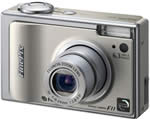
I was wandering through my local Target store last Thursday, and ended up in front of their digital camera display. Looking over their selection, I saw the typical fare... point and shoots from all the major players.. Canon, Sony, Kodak, HP, etc. But there was one that I was surprised to see... the Fuji FinePix F10. It's a typical compact camera, not unlike any other in the category. But it has consistently gotten rave reviews for its low-light capabilities. The F10 incorporates a unique CCD sensor that gives it a pretty decent ISO range up to 800, and is useable, albeit with some noise, at 1600. That's right on par with my Nikon D70.
The F10 is a snappy little camera that's quick to start up and quick to focus. It has a very handy macro mode that takes very good photos up to about 5 inches from the subject. The camera is very solidly built, and looks like it would hold up to normal abuse quite well.
The one thing the F10 has always lacked is manual controls. The average digital camera hobbyist probably wouldn't notice, or care. But for those who want a certain degree of creative control, the F10 has always been considered an incomplete package. The F11 is Fuji's answer to that problem, but they have adamantly insisted the F11 would not be imported to the United States. After all, the F10 was their most popular camera ever. Why would they replace it?
I was ready to put the camera back down and walk away, when I saw the display sign next to it. "Fuji F10 Temporary Price Reduction: $199.99" That's half the normal rate, and well under any price I've ever seen online. To put it in the simplest terms, it was a steal. Unfortunately, it was also out of stock. The electronics salesperson was quick to recognize the camera when I asked for it, saying that it was very popular at that price, and had sold out days earlier, and there was no word as to when they'd get more.
I shrugged it off as bad timing for me, and walked away. But I got the distinct impression that Target was liquidating their stock in order to bring in a different camera. The F11, with manual controls, would be the logical choice.
I predict you'll be seeing the Fuji FinePix F11 in Target stores by the end of March. Selling price will be $389.99
2000 Sebastiani Cabernet Sauvignon (4/5 stars)
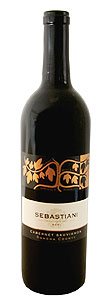
This Sonoma County red was handed to me in a wine shop recently. The label was unassuming, but it being a 2000, I thought it might be a nice ripe wine.
The 2000 growing season was very good in California. And it shows in this wine. The Sebastiani is a nice round wine. I didn't have a chance to sample it immediately after decanting, but an hour later, it was very full in the mouth. Rich and complex, with good up front cherry and blackberry fruit but also with firm tannins. There also seemed to be a hint of chocolate. I could drink this wine all night without tiring of it.
The one thing that I did find a bit odd was an enormous amount of sediment. Thus my earlier comment about decanting.
Prices average in the $12 range. If you can find it under $10, as I did, consider picking up several bottles, but plan to drink it soon. I believe it has peaked and won't last long.
Saturday, February 04, 2006
Friday, February 03, 2006
Nikon Denies Possibility of Making 35mm
Full-Frame Sensor
Industry watchers have been discussing if Nikon Corp., Tokyo, Japan, will come out with a 35mm full-size image sensor in pro-oriented digital SLR. A Nikon top official denied the possibility of making new full-size sensors, Photo Trade Express reports.
"35mm is a film format, which I do not think is necessary in the digital era," says Makoto Kimura of Nikon. "We have been exploring the possibility of commercializing a 35mm full-size sensor, but it's not clear at this moment if we go for it. We feel that the 'DX' format or APS-C size will be the best for the DSLR and interchangeable lenses. Based on the assumption Nikon has been bringing up in number the lenses for the DX format, change in the size of the sensor would possibly puzzle some users in finding effective focal length related to angle of view," he says.
He repeats that Nikon thinks the DX format will be the best for the DSLR, adding CMOS sensor "LBCAST" is also in preparation, reports Photo Trade Express.
Personally, I find the idea that a new sensor would "puzzle some users" to be a cop-out. The fact that most DSLR users are coming from film means they've already had to rethink focal lengths in relation to angle of view. Also, there isn't an exact standard for all digital cameras, so the crop-factor has to be determined for each manufacturer. And let's not even go into medium-format versus 35mm film. Clearly the average photo enthusiast isn't the reason Nikon can't, or rather, won't develop a full-frame sensor. These simpletons that Nikon consider their customers have been begging for a FF-sensor for years.
"35mm is a film format, which I do not think is necessary in the digital era," says Makoto Kimura of Nikon. "We have been exploring the possibility of commercializing a 35mm full-size sensor, but it's not clear at this moment if we go for it. We feel that the 'DX' format or APS-C size will be the best for the DSLR and interchangeable lenses. Based on the assumption Nikon has been bringing up in number the lenses for the DX format, change in the size of the sensor would possibly puzzle some users in finding effective focal length related to angle of view," he says.
He repeats that Nikon thinks the DX format will be the best for the DSLR, adding CMOS sensor "LBCAST" is also in preparation, reports Photo Trade Express.
Personally, I find the idea that a new sensor would "puzzle some users" to be a cop-out. The fact that most DSLR users are coming from film means they've already had to rethink focal lengths in relation to angle of view. Also, there isn't an exact standard for all digital cameras, so the crop-factor has to be determined for each manufacturer. And let's not even go into medium-format versus 35mm film. Clearly the average photo enthusiast isn't the reason Nikon can't, or rather, won't develop a full-frame sensor. These simpletons that Nikon consider their customers have been begging for a FF-sensor for years.
Thursday, February 02, 2006
A camera fit for a 4000 year old king
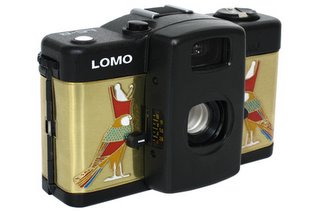
They're selling this over at the Lomographic Society for the princely sum of $350. Ideal for those who want something to capture the decisive moment while crossing the river Styx.
I personally wouldn't buy it, though. I hear it's cursed.
Wednesday, February 01, 2006
2002 Crosspoint Pinot Noir (3/5 stars)
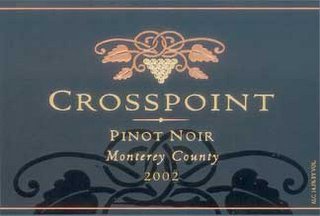
My friendly local wine purvayor smiles whenever I walk in the door. Mostly because he knows he can talk me into dropping $80 on wine without too much trouble. But he also knows that I visit him to find out what his latest steal is. By that I mean a wine that he found for well under the market price. He never disappoints, and I think he likes having an appreciative customer who he can share his good fortune with. I'm a big fan of burgundies, and he sets aside his best values for me to have first dibs on. Such is one of the perks of the $80 a visit relationship that we have.
His most recent gem was several cases of 2002 Crosspoint pinot noir. This wine needs no more than a half hour to open up, but even then it's not a big wine. Characterized by aromas of cherry jam, rhubarb and stewed strawberries with a faint touch of sage underbrush spiciness, it's a soft, fruit flavored, spicy wine with layers of complexity makes it an ideal accompaniment to roast duck with dried cherries and veal-based risottos.
You'll notice I rate this wine at 3 out of 5 stars. I'm tempted to rate it a little higher based on value. Normally this wine sells for $12. I picked up a case for $60. I think I'll go drink some more of my new house wine and continue gloating now.

